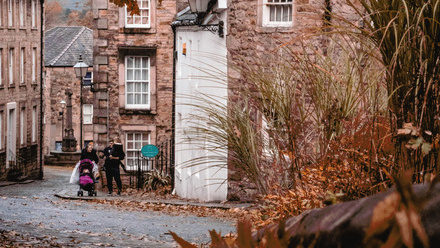NALC at the LGA Annual Conference 2024
Every year, we attend the Local Government Association Annual Conference to discuss the local government sector with principal authorities, engage with other organisations, and increase the visibility of parish and town councils. This year, we will attend between 22 and 24 October 2024 at the Harrogate Convention Centre. We'll be exhibiting on Stand Q119, hosting a fringe event, and supporting an Innovation Zone session. We'll share our Did You Know Flyer with attendees, spotlighting the fantastic work parish and town councils do nationwide.
Fringe event: Working together to build stronger communities
We'll be holding a fringe event on 23 October 2024 between 5:15 pm and 6:15 pm in Queen's Suite 2 at the Harrogate Convention Centre on how working together can build stronger communities.
We believe partnership at the national and local levels is the key to tackling some of our country's biggest challenges. The government alone cannot deliver any mission for change and national renewal, with economic growth and opportunity at its heart. But what part should local government at all levels, particularly England's 10,000 parish and town councils, play to build stronger communities? How can they help financially challenged principal authorities? And what opportunities are there to help build more homes, improve health and wellbeing, keep people safe or support young people, provide green spaces, or improve community resilience?
Join us for an end-of-the-day discussion and debate with our expert panellists to discuss all these questions and more. This lively and thought-provoking session will take place over drinks and canapés. It is the perfect way to end your day before the evening's networking and dinners.
Speakers include Helen Ball of Shrewsbury Town Council, Sarah Calkin of the Local Government Chronicle, Fiona Howie of the Town and Country Planning Association and Leigh Middleton OBE of the National Youth Agency.
Innovation Zone: Braunstone Town Council
We'll be supporting Braunstone Town Council at their Innovation Zone session on 23 October 2024 between 10:35 am and 11:05 am on Stage 3 of the Innovation Zone at Harrogate Convention Centre on improving sustainable transport links in Braunstone through collaboration and delivering on multiple objectives.
As part of its commitment to respond to climate change and to connect the local community, our Star Council Awards Council of the Year 2023 winner, Braunstone Town Council, collaborated with the neighbouring city, county and district councils to deliver improved walking and cycling connections between residential areas, transportation hubs, retail zones, leisure spots, and employment areas. The project is an example of how councils and third-sector organisations can work together across administrative boundaries and at different tiers to deliver multiple objectives and provide infrastructure that meets the needs of local communities and the wider area.
Articles
In our latest article series, we asked our fringe event speakers to write an article on how parish and town councils can tackle some of the country’s most pressing challenges, from supporting principal authorities and building more homes to improving health and wellbeing and engaging with young people.
National Youth Agency
Author: Leigh Middleton OBE, chief executive of the National Youth Agency
How parish and town councils can play a role in supporting young people’s wellbeing
Young people in our communities have the odds stacked against them – with services unable to meet their mental health struggles, risks of online harm and exploitation and a feeling that their voices aren’t heard. Our survey of young people earlier this year revealed that they are crying out for youth work activities that provide them with fun activities and, importantly, a sense of belonging that youth work provides.
Parish and town councils, located in the beating heart of communities, know their young people better than anyone and can do so much to turn around this depressing picture.
It’s no mystery why local youth services haven't been able to keep apace of young people's needs, with some £1.1 billion being cut from local authority budgets since 2010, resulting in an exodus from the youth sector and the voluntary sector carrying the can. In addition, young people have missed out on school during the pandemic and are now contending with an ongoing cost of living crisis; there’s also a heartbreaking increase in the number of looked-after children. Despite this, around two million young people in England engage with a youth service at least once a week – some 35% of those in secondary school and further education (aged 11 to 19).
An updated local authority statutory duty for youth work
Last year, the government published updated guidance for local authorities to help ensure their youth offer cuts the mustard, and parish and town ouncils can play a role in contributing to this new benchmark of sufficiency.
Indeed, the National Association of Local Councils (NALC) young people case studies lists some of those leading the march in this regard. The UK Shared Prosperity Fund has also supported some local youth offers, with parish and town councils applying for grants through their princial authority. This has resulted in pockets of funding going into the youth work sector.
A beacon model of funding in South Gloucestershire
Hats off to South Gloucestershire Youth Service, which engaged parish and town councils in a new tendering model launched in 2018 to create a more sustainable and joined-up youth offer involving the voluntary sector. From the outset, it was emphasised that the current youth service budget could not stretch to ensure provision could happen in all areas of South Gloucestershire. If parish and town councillors wanted provision delivered in their local area, they needed to contribute by raising funds through precept.
This has resulted in more sustainable projects, with the voluntary sector bringing in matched funding through a more cohesive Youth Activities Offer, which now includes additional provision for young LGBQ+ people and a new service for those aged 11 to 13 (at the critical transition point where they often falter).
The benefits of this joined-up commissioning model are:
- It helps councils fulfil their statutory duty and stretch their available budget – as well as doubling individual contract value with the matched funding.
- Contracts, as managed by the local authority, are for seven years, as opposed to the restrictive 12-month parish and town council contract limit, providing greater financial security for local grassroots youth organisations.
- The local authority shoulders the financial risk and responsibility, as well as safeguarding, quality assurance, and contract monitoring. This has enabled a number of programmes, such as the violence reduction partnership, holiday activities and food programme, and other targeted programme work, to thrive beyond the short term.
- The local authority collates a shared outcomes framework with youth organisations, which provides a shared understanding of the provision's impact.
If you’re new to youth work, the National Youth Agency (NYA) website has a plethora of information and resources to help demystify the local authority statutory guidance and illustrate effective youth work practice.
Hopefully, I’ll see you at NALC's fringe, Working together to build stronger communities, on 23 October 2024 between 17:15 and 18:15 in the Queen’s Suite 2, or come and visit the NYA stand at conference (stand number Q73). I’d love to talk to you directly about how you can help build a more positive future for your young people.
Shrewsbury Town Council
Helen Ball, town clerk at Shrewsbury Town Council
Local government finances: The biggest threat or the greatest opportunity to parish and town councils?
Local government is a crucial aspect of the governance of the UK, particularly for parish and town councils (local councils). These councils are the most local tier of government, tasked with addressing grassroots issues, engaging with the community, and managing local resources and services. They enjoy autonomy from upper-tier local authorities, and the central government is not bound by referendum principles and has the ability to develop services that meet very local needs.
However, the financial environment within which parish and town councils now operate has been fraught with challenges, largely stemming from austerity measures, changes to government policy and rising expectations.
Upper-tier authorities are in crisis, with many facing the prospect of their adult and social care responsibilities outstripping their total budget. This means that those grassroots services that many unitary, county and district councils provide, like quality public realm management, recreation and cultural activity and those safety measures like CCTV, are at serious risk.
Shropshire Council is not uncommon with the dawning reality of saving tens of millions of pounds to meet rising social care costs. Its programme of budget cuts requires alternative funding models to be sourced for its cultural assets like sports centres and theatres as well as street scene services cut to a bare minimum. The prospect of losing those jam and cream in the cake services that make Shropshire a wonderful place to live, work, and visit does not bear thinking about. The news regularly features upper tier authorities facing the prospect of closing parks and play areas.
Such desperate times have called for Shropshire Council officers and elected members to start discussions with the 167 parish and town councils that stretch over its 1,000 square miles. Parishes vary hugely in Shropshire, from the village of Ashford Bowdler, with a population of 64, to the county Town of Shrewsbury, with a population of 76,782. Many of these local councils already manage local services such as parks, community centres, streetlights and allotments. This call for help has been received in very different ways; some have looked to be supportive, whilst others have totally dismissed the idea.
Over the last 15 years, local government in the UK has faced a severe squeeze in funding as part of austerity measures introduced through the 2008 financial crisis. Over the last five years alone, COVID-19 has had major effects not just on funding but also on the social capital of communities, and whilst it is acknowledged that upper-tier authorities have absorbed the bulk of these cuts, the knock-on effects are trickling down to parish and town councils and in many cases local authorities have devolved responsibility for services to parish councils without providing an adequate resource to manage them.
This financial strain has created several challenges for parish and town councils:
- Increased demand for services – As local authorities reduce and in some cases stop services, local councils often face pressure from residents to fill the gap. This is often done by supplementing stripped back services provided by local authorities or taking over the service completely.
- Limited revenue streams – Local councils heavily rely on the precept for their funding. In many communities, there is little appetite for raising the precept for fear of the ramifications for the ratepayer once the council tax bill drops on the doormat. Parish council precepts are minimal compared to other lines of the bill, with the average Band D rate being less than £100 a year, but it is often the perception that a percentage increase is more the issue than the sum.
- Capacity – Is probably one of the greatest challenges to the sector. Whilst there are some of the larger town councils in the country having significant capacity to take on services there are many parish councils that employ a part time clerk with little more than administrative capacity.
Despite these challenges, local government finances also present significant opportunities for parish and town councils, particularly if they adopt innovative approaches to manage their services, resources and income generation.
- Localism and devolution – Legislation already exists to devolve power to local communities. While devolution often comes with financial pressures, it also offers parish and town councils the chance to take on greater responsibility and engage more with their communities. This can enhance the role of local councils and empower them to shape the future of their areas.
- Different funding streams – Parish councils can explore alternative funding mechanisms. Whilst many of the national funders are accessible by parish councils, the sector remains restricted by the fact that government-funded schemes are invariably directed through the upper tier authorities.
- Partnership and collaboration – Across the country, there are some fantastic examples of parish councils working together to provide services that cross over administrative boundaries and being the facilitators of local partnerships, bringing local organisations together to address a common goal. This has meant that resources, skills, funds, and time can all be shared to maximise the benefit.
To reduce the threat and maximise the opportunities relies on a collective approach across not just local government but also the many organisations which support the sector. At the parish council level, the National Association of Local Councils (NALC) and the Society of Local Council Clerks (SLCC) do a sterling job in supporting councils as corporate bodies, the elected members, as well as clerks and wider staff and both bodies, recognise that the parlous state of local government finances means that the level of support needs to change. But it needs the wider local government family to help.
- This isn’t about merely transferring financial burden from the upper tier to the lower tier of local government; after all they both serve the same tax payers and electors. This is about looking at ways in which the two tiers can work more collaboratively and efficiently.
- This is about recognising that there is work to be done to improve the capacity of the local council sector and in the same way we see local authorities investing to save why shouldn’t local councils be seen in the same way.
- This is about government recognising that local government does not stop at local authority level and parish councils have a significant role to play in meeting national priorities. In the civic county of Shropshire, the two new MPs for Shrewsbury and Telford have been parish councillors and there will be many more who have witnessed first hand the real difference the sector can make.
To do this, we need to adopt a forward-thinking approach, which includes:
- Strategic planning – This develops long-term sustainability at the grassroots level.
- Capacity building – Investing in the skills and expertise of not just local council staff but the organisations that support the sector.
- Community engagement - Involving residents in decision making and fostering a sense of collective responsibility for local services.
In conclusion the parish and town council sector has been around since its creation in 1894 and in the last 130 years has seen great change in local government. They are still here so must be testimony to the continuity and stability they give to communities.
Let’s collectively work together to make sure they deliver for many more years to come.
Society of Local Council Clerks
Michael King, head of policy and external communications at the Society of Local Council Clerks
Local councils: Powering community actions in the 21st century
In the heart of many a thriving community lies an often-overlooked powerhouse: its local council. And supporting the members of the local council are its staff. Local councils are not just pushing paper – they’re driving real change right on your doorstep.
The Society of Local Council Clerks (SLCC) is the professional body representing practitioners in the most local tier of government across England and Wales. In collaboration with the National Association of Local Councils (NALC), we are committed to ensuring that all in the sector: clerks, councillors and councils, have access to professional advice and support. We strongly encourage councillors and councils to become members of their county associations and NALC while also advocating for clerks to join SLCC and actively engage with their local county branches. This ensures a strong and effective partnership to support clerks, councillors and councils in delivering for their places – building stronger, more resilient communities.
Picture this: a local council that's as switched-on as you are. We're talking about e-enabled services, a sense of community and pride in place. It's about making decisions at the right level – as close to you as possible. We call it the principle of subsidiarity, but you can think of it as ’keeping it local’.
All local councils provide local services and hold community assets in the public good. Local councils also rely on commissioning services from the private sector. Now, here's where it gets interesting. When local councils need something done, they look to local businesses first. It's like keeping it in the family but with better accounting. This approach doesn't just provide services; it keeps your hard-earned cash circulating in the community. It's a win-win situation that bigger government is often forced to overlook.
Your local councillors are local and accessible – they're your neighbours, dedicated to making your community thrive. The staff at your local council aren’t just employees; they have a deep understanding of local needs because they live with them every day. This intimate knowledge of the community is their secret weapon, allowing them to craft custom-built solutions that truly fit local needs.
But let's face it, it's not all smooth sailing. Social media can be a bear-pit, turning local debates into online shouting matches. That's why we're championing civility and respect, both within councils and between them and their communities. We’re not interested in keyboard warriors – we want real dialogue that gets things done.
With local support, our local councils can achieve so much. When their relationships with other tiers of local government are built on mutual understanding and respect, they do the most by minimising bureaucracy and the costs of commercial models of doing business between public authorities. The founding legislation in the 1972 Local Government Act enables joint working, joint commissioning and agency agreements. So many of the intervening years have made these harder to achieve at both ends of that relationship. Sounds boring, right? But these are the tools that allow councils to punch above their weight.
Local councils are not just talking about maintaining the status quo. They’re about transforming local governance for the 21st century. They need a framework that allows councils to exercise their power of general competence by working together and acting as a team – in other words, the freedom to innovate and find creative solutions to local problems.
Imagine a local council that can quickly respond to community needs, whether it's setting up a youth centre, creating green spaces, or launching initiatives to support local businesses. You may not have to imagine. You may have that already. That's the kind of agile, responsive local government we're working for.
In a nutshell, your local council is your local champion, fighting to make your community the best it can be. We're cutting through the red tape, keeping it local, and making every penny count. They’re committed to translating your desires and calls for action into effective, robust local plans and delivery.
Town and Country Planning Association
Author: Fiona Howie, chief executive of the Town and Country Planning Association
Working together to build stronger communities – the importance of planning and place-shaping
The Town and Country Planning Association (TCPA) is committed to making sure that people live in homes, places and communities that enable everyone to thrive. To achieve that, we believe we need new and existing places to be healthy, sustainable, resilient and fair for everyone. Making that happen is, of course, not easy. And we most certainly can’t do it alone. So, working together at neighbourhood, local, national and international levels, and across sectors, is essential.
The built and natural environments have profound impacts on people’s health, wellbeing and life chances. This was understood by the founders of the Garden City movement, who created the TCPA (originally known as the Garden City Association) 125 years ago to drive forward the creation of a Garden City. Letchworth Garden City was an experiment that aimed to demonstrate that high-quality, equitable and healthy places could be built that enabled people to live, work and play in improved conditions compared to the urban slums of the time.
Today, rather than seeing planning and placemaking as an important way in which we can improve people’s lives, our national politicians often argue that planning is a barrier to growth. And reforms often seek to ‘get it out of the way’. In contrast, the TCPA remains clear that the planning system can be transformational. If properly resourced and with the right policy levers available, it can and should play a central role in tackling the housing, health, climate and nature crises. But, to do that, we need those shaping and using the planning system to be visionary and ambitious.
Since the General Election, there has been a flurry of announcements with the aim of getting more homes built. Regardless of what is happening at the national level, we know important work has been happening and will continue to happen at neighbourhood and local levels.
Part of the TCPA’s work focuses on trying to share examples of good practices to inspire others to be more ambitious. While there is a lack of resources in local government, there are still lots of fascinating examples out there. These include Cornwall Council’s Development and Decision Wheel, which is based on doughnut economics and looks at decisions through environmental, social and inclusion lenses. And a national cultural planning toolkitcommissioned by Creative Estuary and Kent County Council to better support thriving places through securing and embedding arts and cultural infrastructure through the planning system. We also published a hub of practical examples of actions that planners can take to address climate change through local plan policies.
While we hope these examples are useful, we are very mindful that even where local authorities may have positive policies in local plans, they need to work in partnership with communities, local stakeholders, and the private sector to make change happen on the ground. And the relationship between parish and town councils and local planning authorities is often crucial in. Whether that is through the development of a neighbourhood plan, co-creating a master plan for a regeneration scheme, or taking on the stewardship of community assets so they can be managed and maintained in the long term.
There are lots of fantastic examples of neighbourhood plans out there, but people might be less aware of the mechanisms necessary to make sure that places can be looked after in perpetuity. This is what we mean by long term stewardship and we see it as a critically important, but often overlooked, ingredient in supporting high quality places and environments to continue to be high quality in the long-term.
One example where the Town Council has played a central role is the new settlement of Cambourne, in South Cambridgeshire, which has around 4,350 homes. Using income from their precept, as well as additional income streams such as hiring out facilities, the Town Council owns and manages seven community buildings and a wide range of sports facilities and manages elements of the 250ha of greenspace. The local Wildlife Trust also has a role in managing parts of the greenspaces, including a woodland. I recognise such an arrangement will not be possible everywhere. However, the mechanisms by which community assets will be maintained for years to come are important to think about in both new and existing places. This is also relevant for Biodiversity Net Gain, which has to be managed and maintained for 30 years.
Inevitably there is much detail that sits underneath the Cambourne example because supporting people and places to thrive now and in the long-term involves many people and organisations. The planning system can’t tackle all elements of what makes a strong community but, when properly resourced and in ambitious hands, it can be transformational.






